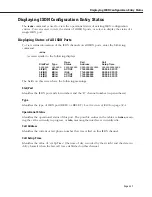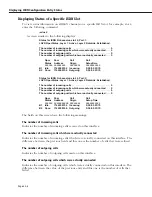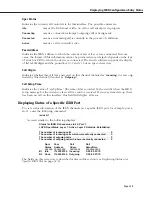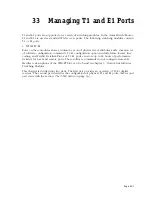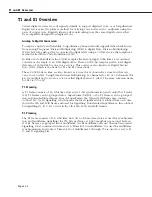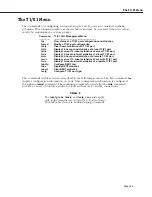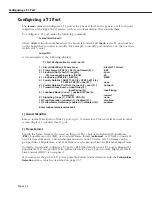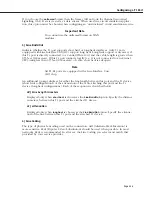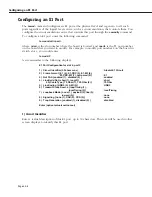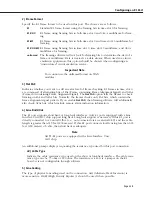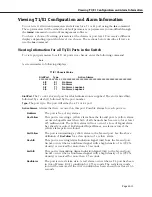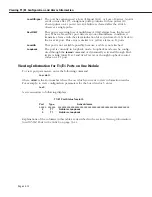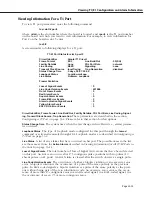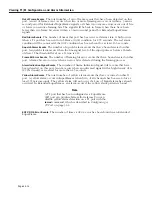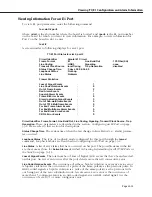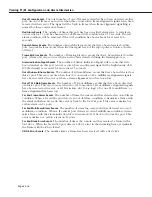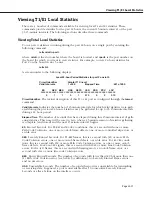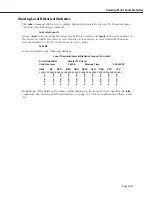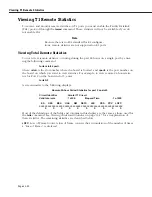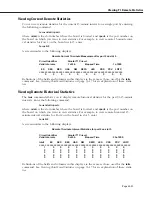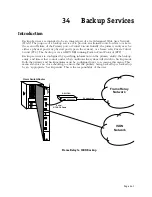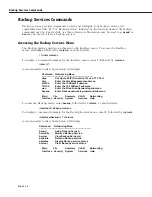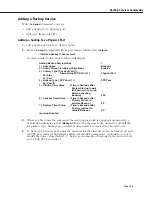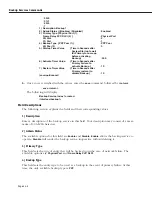
Viewing T1/E1 Configuration and Alarm Information
Page 33-11
Viewing T1/E1 Configuration and Alarm Information
You can view all current parameters and alarms for a
T1 or E1
port using the
tes
command.
These parameters will be either the default parameters or parameters you modified through
the
temod
command or network management software.
You have a choice of viewing parameters at the chassis or port level. You receive different
displays depending upon which level you choose. The sections below describe all ways to
use the
tes
command.
Viewing Information for all T1/E1 Ports in the Switch
To view port parameters for all
T1/E1
ports in a chassis, enter the following command
tes
A screen similar to following displays:
T1/E1 Chassis Status
Slot/Port
Type
Active Alarms
========= ====== ======================================================
4/2
E1
NoAlarm
4/3
E1
NoAlarm
5/2
T1
NoAlarm, Loopback
5/3
T1
NoAlarm, Loopback
Slot/Port.
The
T1
or
E1
slot and port for which information is supplied. The slot is listed first,
followed by a slash (
/
), followed by the port number.
Type.
The port type. The port will either be a
T1
or
E1
port.
Active Alarms
. Alarms that have occurred on this port. Possible alarms for each port are:
NoAlarm
The port is free of any alarms.
RcvYellow
This port is receiving a yellow alarm from the far-end port. A yellow alarm
occurs in SuperFrames when bit 6 of all channels has been zero for at least
425 milliseconds. The yellow alarm will not occur if a Loss of Signal alarm
has already occurred. In Extended SuperFrames, an alarm occurs if the
yellow alarm pattern is found.
XmtYellow
The port is transmitting a yellow alarm
to
the far-end port. See the above
definition of
RcvYellow
for a description of a yellow alarm.
RcvAIS
This port is receiving Alarm Indication Signal (
AIS
) from the far-end port.
An
AIS
occurs when an unframed signal with a high density of 1s (99.9%
density) is received for more than 1.5 seconds.
XmtAIS
This port is transmitting Alarm Indication Signal (
AIS
)
to
the far-end port.
An
AIS
occurs when an unframed signal with a high density of 1s (99.9%
density) is received for more than 1.5 seconds.
RedAlarm
The port is in red alarm state. A red alarm occurs when a T1 port has been
in Out-of-Frame (
OOF
) condition for 2.55 seconds. The red alarm condi-
tion will be removed if the
OOF
condition has been absent for at least 16.6
seconds.
Summary of Contents for Omni Switch/Router
Page 1: ...Part No 060166 10 Rev C March 2005 Omni Switch Router User Manual Release 4 5 www alcatel com ...
Page 4: ...page iv ...
Page 110: ...WAN Modules Page 3 40 ...
Page 156: ...UI Table Filtering Using Search and Filter Commands Page 4 46 ...
Page 164: ...Using ZMODEM Page 5 8 ...
Page 186: ...Displaying and Setting the Swap State Page 6 22 ...
Page 202: ...Creating a New File System Page 7 16 ...
Page 270: ...Displaying Secure Access Entries in the MPM Log Page 10 14 ...
Page 430: ...OmniChannel Page 15 16 ...
Page 496: ...Configuring Source Route to Transparent Bridging Page 17 48 ...
Page 542: ...Dissimilar LAN Switching Capabilities Page 18 46 ...
Page 646: ...Application Example DHCP Policies Page 20 30 ...
Page 660: ...GMAP Page 21 14 ...
Page 710: ...Viewing the Virtual Interface of Multicast VLANs Page 23 16 ...
Page 722: ...Application Example 5 Page 24 12 ...
Page 788: ...Viewing UDP Relay Statistics Page 26 24 ...
Page 872: ...The WAN Port Software Menu Page 28 46 ...
Page 960: ...Deleting a PPP Entity Page 30 22 ...
Page 978: ...Displaying Link Status Page 31 18 ...
Page 988: ...Displaying ISDN Configuration Entry Status Page 32 10 ...
Page 1024: ...Backup Services Commands Page 34 14 ...
Page 1062: ...Diagnostic Test Cable Schematics Page 36 24 ...
Page 1072: ...Configuring a Switch with an MPX Page A 10 ...
Page 1086: ...Page B 14 ...
Page 1100: ...Page I 14 Index ...

